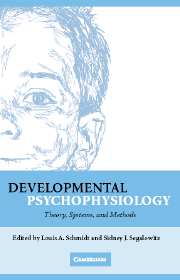Book contents
- Frontmatter
- Contents
- Foreword by Stephen W. Porges
- Preface
- Acknowledgments
- Contributors
- 1 Capturing the Dynamic Endophenotype: A Developmental Psychophysiological Manifesto
- SECTION ONE CENTRAL SYSTEM: THEORY, METHODS, AND MEASURES
- 2 Event-Related Brain Oscillations in Normal Development
- 3 Event-Related Potential (ERP) Measures in Auditory Development Research
- 4 Event-Related Potential (ERP) Measures in Visual Development Research
- 5 Electrophysiological Measures in Research on Social and Emotional Development
- 6 The Use of the Electroencephalogram in Research on Cognitive Development
- SECTION TWO AUTONOMIC AND PERIPHERAL SYSTEMS: THEORY, METHODS, AND MEASURES
- SECTION THREE NEUROENDOCRINE SYSTEM: THEORY, METHODS, AND MEASURES
- SECTION FOUR DATA ACQUISITION, REDUCTION, ANALYSIS, AND INTERPRETATION: CONSIDERATIONS AND CAVEATS
- Index
- References
4 - Event-Related Potential (ERP) Measures in Visual Development Research
from SECTION ONE - CENTRAL SYSTEM: THEORY, METHODS, AND MEASURES
Published online by Cambridge University Press: 27 July 2009
- Frontmatter
- Contents
- Foreword by Stephen W. Porges
- Preface
- Acknowledgments
- Contributors
- 1 Capturing the Dynamic Endophenotype: A Developmental Psychophysiological Manifesto
- SECTION ONE CENTRAL SYSTEM: THEORY, METHODS, AND MEASURES
- 2 Event-Related Brain Oscillations in Normal Development
- 3 Event-Related Potential (ERP) Measures in Auditory Development Research
- 4 Event-Related Potential (ERP) Measures in Visual Development Research
- 5 Electrophysiological Measures in Research on Social and Emotional Development
- 6 The Use of the Electroencephalogram in Research on Cognitive Development
- SECTION TWO AUTONOMIC AND PERIPHERAL SYSTEMS: THEORY, METHODS, AND MEASURES
- SECTION THREE NEUROENDOCRINE SYSTEM: THEORY, METHODS, AND MEASURES
- SECTION FOUR DATA ACQUISITION, REDUCTION, ANALYSIS, AND INTERPRETATION: CONSIDERATIONS AND CAVEATS
- Index
- References
Summary
INTRODUCTION
Visual abilities undergo major transformation during infancy and childhood. Although infants arrive in the world both able to see and to learn about what they see, many aspects of vision and visual cognition continue to develop well into childhood (e.g., Chung & Thomson, 1995; Lewis & Maurer, 2005). Event-related potentials (ERPs) are a useful tool for investigating the neurophysiological correlates of these developmental changes as they can provide information not available from behavioral measures alone. In particular, they provide precise information about the timing and some information about the spatial distribution of the brain events underlying visual processing. Since ERPs can be obtained in “passive” tasks, where participants simply look at visual displays without any requirement to make a verbal or behavioral response, they allow use of the same procedure across a wide range of age and ability levels. For example, visual ERPs have been used to study face processing in infants only a few months old (e.g., Halit, de Haan, & Johnson, 2003) and have been used to investigate aspects of visual processing in children with various developmental disorders, including autism spectrum disorder (e.g., Dawson et al., 2002; Kemner, van der Gaag, Verbaten & van Engeland, 1999), Down syndrome (e.g., Karrer et al., 1998), and attention deficit-hyperactivity disorder (reviewed in Barry, Johnstone, & Clarke, 2003). Along with these distinct advantages, however, ERPs also present challenges both in terms of experimental design and data collection, and analysis and interpretation.
Information
- Type
- Chapter
- Information
- Developmental PsychophysiologyTheory, Systems, and Methods, pp. 103 - 126Publisher: Cambridge University PressPrint publication year: 2007
References
Accessibility standard: Unknown
Why this information is here
This section outlines the accessibility features of this content - including support for screen readers, full keyboard navigation and high-contrast display options. This may not be relevant for you.Accessibility Information
- 1
- Cited by
